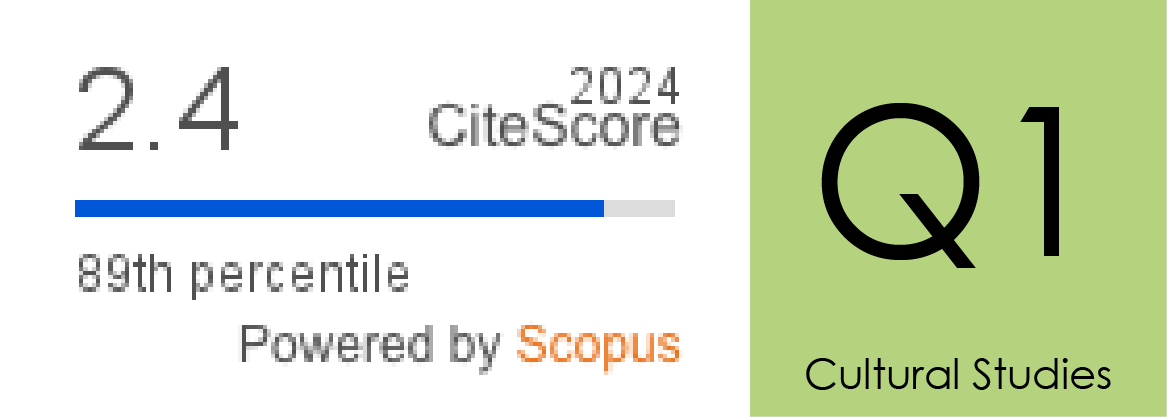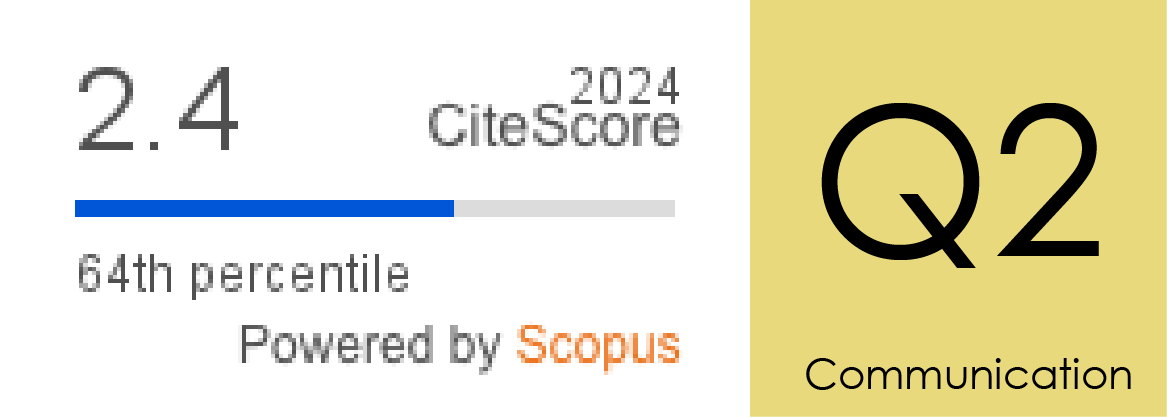Perfil de los minoristas independientes de moda en Escocia desde el modelo de estrategia competitiva genérica de Porter y el mix de marketing
DOI:
https://doi.org/10.14198/MEDCOM2018.9.1.23Palabras clave:
Venta de moda al por menor independiente, Marketing mix, Estrategia de mercadoResumen
Los minoristas independientes en el sector de la moda hacen una contribución sustancial a la economía del Reino Unido en el momento de un cambio significativo debido a las presiones financieras y el crecimiento del comercio en línea. Proporcionan un elemento de creatividad e innovación a un paisaje minorista homogéneo. El distribuidor independiente de moda crea un destino y una identidad individual al presentar una oferta única y una experiencia diferenciada. Mientras que los minoristas independientes son importantes para el futuro, la investigación es limitada, sobre todo en el área de empresas independientes de la moda. Por lo tanto, esta investigación examina e identifica las características únicas de los minoristas independientes de moda en Escocia. La investigación adopta un enfoque de estudio de caso, métodos cualitativos de recolección de datos con el fin de cumplir con los objetivos del estudio. Las Estrategias Competitivas Generales de Porter y la mezcla de mercadeo se utilizaron como un medio de extraer los aspectos individuales y las características únicas del minorista de moda independiente.
Citas
Balasescu, S. (2014). Contributions to the foundations of the marketing mix for retail companies. Bulletin of the Transilvania University of Brasov, Economic Sciences, 7(1), 17-24. Disponible en https://goo.gl/xsns4L
Ballantine, P.W.; Parsons, A. & Comeskey, K. (2015). A Conceptual model of the holistic effects of atmospheric cues in fashion retailing. International Journal of Retail & Distribution, 43(6). https://doi.org/10.1108/IJRDM-02-2014-0015
Birtwhistle, G.; Clarke, I. & Freathy, P. (1998). Customer Decision Making in Fashion Retailing: a segmentation analysis. International Journal of Retailing & Distribution Management, 26(4), 147-154. https://doi.org/10.1108/09590559810214912
British Independent Retail Association (BIRA) (2016). [Página web]. Disponible en https://goo.gl/FwXwx3
Britten, F. (29/09/2006). New meaning for the term Niche market. New York Times. Disponible en https://goo.gl/wbd2nD
Broadbent, M.; Darke P. & Shanks, G. (2002). Successfully Completing Case Study Research. Information Systems Journal, 8(4), 76-85. http://dx.doi.org/10.3127/ajis.v10i1.448
Bruce, M. & Hines, (2001). Fashion Marketing, Contemporary Issues. Oxford: Butterworth Heinmann.
Bryman, A. & Bell. E, (2007). Business Research Methods. Oxford: Oxford University Press.
Clarke, D.; Denson, H. & Perry (2012). The sensory retail environment of small fashion boutiques. Journal of Fashion Marketing and Management, 16(4), 492-510. https://doi.org/10.1108/13612021211265872
Collis, J. & Hussey, R. (2014). Business Research: A practical guide for undergraduate and postgraduate students. London: Palgrave MacMillan. https://doi.org/10.1007/978-1-137-03748-0
Cummins, D.; Gilmore, A.; Carson, D. & O’Donnell, A. (2008). What is innovative marketing in SME’s ? Towards a conceptual and descriptive framework. En AMA Conference proceedings. Stirling University, Stirling.
Dalgic, T. & Leeuw, M. (2006). Niche Marketing revisited concept, applications and some European cases. European Journal of Marketing, 28(4), 39-55.
https://doi.org/10.1108/03090569410061178
Darke, P.; Shanks, G. & Broadbent, M. (2002). Successfully completing case study research: combining vigour, relevance and pragmatism. Information Systems Journal, 8(4), 273-289. https://doi.org/10.1046/j.1365-2575.1998.00040.x
Dawson, J.; Findlay, A. & Sparks, L. (2008). The Retailing Reader. Oxon: Routledge.
Denscombe, M. (1998). The Good Research Guide. Buckingham: Open University.
Diamond, E. (2015). Fashion Retailing: A Multi-Channel Approach. New Jersey: Pearson/Prentice Hall.
Donnell, L.; Hutchinson, K. & Reid, A. (2012). Fashion retailing in the new economy: the case of SME’s. International Journal of Retail & Distribution Management, 40(12), 906-919. https://doi.org/10.1108/09590551211274919
Doyle, P. & Stern, P (2006). Marketing Management and Strategy. Hawlow: Prentice Hall.
Drapers & Damon’s (2016). [Página web]. Disponible en https://goo.gl/IMcAGJ
Easey, M. (2009). Fashion Marketing. Oxford: Blackwell Science.
Easterby-Smith, M.; Thorpe, R. & Jackson, P. (2012). Management Research. Washington DC: Sage Publications.
Freathy, P. (2003). The Retailing Book: Principles and Applications. Essex: Prentice Hall.
Frings, G. (2008). Fashion from Concept to Consumer. New York: Pearson Prentice Hall.
Ghauri, P. & Gronhaug, K. (2005). Research Methods in Business Studies: A Practical Guide. Harrow: Prentice Hall.
Gilbert, D. (1999). Retail Marketing Management. Harlow: Prentice Hall.
Gilbert, D. & Sumner, F. (2004). The current use of marketing in UK retailing. International Journal of Retail & Distribution Management, 32(5), 242-251. https://doi.org/10.1108/09590550410534587
Goworek, H. & McGoldrick, P. (2015). Retail Marketing Management: Principles and Practice. Harlow: Pearson.
Grewal, D.; Levy, M. & Kumar, V. (2014). Customer experience management in retailing: an organising framework. Journal of Retailing, 85(1), 1-14. https://doi.org/10.1016/j.jretai.2009.01.001
Hall, J. (01/03/2012). Boon for market towns as independent shops increase. The Telegraph. Disponible en https://goo.gl/r95VI
Hutter, K. & Hoffmann, S. (2014). Surprise, Surprise, Ambient Media as Promotion Tool for Retailers. Journal of Retailing, 90(1), 93-110. https://doi.org/10.1016/j.jretai.2013.08.001
Hezar, I.; Dalgic, T.; Phelan, S. & Knight, G. (2006). Principles of
Global Niche Marketing Strategies: an early conceptual framework. En Dalgic, T. (Ed.), Handbook of Niche Marketing (pp. 26-63). New York: The Hawthorn Press.
Hristov, L. & Reynolds, J. (2015). Perceptions and practices of innovation in retailing: challenges of definition and measurement. International Journal of Retail & Distribution Management, 43(2), 126-147. https://doi.org/10.1108/IJRDM-09-2012-0079
Jackson, T. & Shaw, D. (2009). Mastering Fashion Marketing. Hampshire: Palgrave Macmillan. https://doi.org/10.1007/978-1-137-09271-7
Jankowicz, A. D. (2000). Business Research Projects. London: Thomson Learning.
Kim, J.B.; Koo, Y. & Chang, D.R. (2009). Integrated brand experience through sensory branding and IMC. Design Management Review, 20(3), 72-81. https://doi.org/10.1111/j.1948-7169.2009.00024.x
Kotler, P. (1999). Kotler on Marketing: How to create, win and dominate markets. New York: The Free Press.
Kotler, P. (2003). Marketing Management. New York: Prentice Hall.
Kotler, P. & Keller, K.L. (2006). Marketing Management. M.U.A.: Pearson Education.
Linneman, E.R. & Stanton L.J. (1991). Making Niche Marketing Work: How to grow bigger by acting smaller. New York: McGraw-Hill.
McCormick, H.; Cartwright, J. & Perry, P. (2014). Fashion Retailing – past, present and future. Textile Progress, 46(3), 227-321. https://doi.org/10.1080/00405167.2014.973247
McGregor, L. (2013). Get Involved: independent retailers need to enhance the instore experience for today’s tech savvy shoppers. Earnshaw’s infant-girls-boys wear review. 97(3), 40.
McGuiness, D. & Hutchinson, K. (2013). Utilising product knowledge: Competitive advantage for specialist independent grocery retailers. International Journal of Retail & Distribution Management, 41(6), 461-476. https://doi.org/10.1108/09590551311330834
Montgomery, C.A. & Porter, M.E. (1991). Strategy: seeking and securing competitive advantage. Boston: Harvard business review book series.
O’Dwyer, M.; Gilmore, A. & Carson, D. (2009). Innovative marketing in SME’s: a theoretical framework. Emerald: European Business Review. https://doi.org/10.1108/09555340910998805
Omar, O. & Kent, T. (2003). Retailing. Hampshire: Palgrave Mcmillan.
Porter, M.E. (1983). Competitive Advantage: Creating and Sustaining Superior Performance. New York: The Free Press. https://doi.org/10.1007/978-1-349-14865-3
Porter, M.E. (1990). The Problem with Porter’s Generic Strategies. European Management Journal, 8(4), 443-450. https://doi.org/10.1016/0263-2373(90)90104-E
Porter, M.E. (1998). The competitive advantage of nations: with a new introduction. London: McMillan Business.
Porter. M.E. (2004). Competitive Advantage: Creating and Sustaining Superior Performance, with a new introduction. New York: The Free Press.
Portas, M. (2011). The Portas Review. An independent review into the future of our high street. Disponible en https://goo.gl/DUqRk8
Quinn, B.; McKitterick, L.; McAdam, R. & Brennan, M. (2013). Innovation in small scale retailing: a future research agenda. The International Journal of Entrepreneurship and Innovation, 14(2), 81 - 93. https://doi.org/10.5367/ijei.2013.0111
Sands, S. & Ferrano, C. (2010). Retailers strategic response to economic townturn: insight from down under. International Journal of Retailing & Distribution Management, 38(8), 567-577. https://doi.org/10.1108/09590551011057408
Silverman, D. (2005). Doing Qualitative Research. London: Sage Publications.
Smith, L. & Sparks, L. (2000). The International Review of Retail, Distribution and Consumer Research: The role and function of the independent small shop: the situation in Scotland. London: Routledge.
Spellman, R. (2011). Managers and Leaders who can: Operating in the New Economy. Chivester: Wiley.
Stokes, D. & Wilson, N. (2010). Small Business Management and Entrepreneaurship. Hampshire: Southern Western.
Tevfik, D. (2006). Handbook of Niche Marketing, Principles and Practice. New York: Routledge.
Tevfik, D. & Leeuw, M. (1994). Niche Marketing Revisited: Concept, Application and some European cases. European Journal of Marketing, 28(4), 39-55. https://doi.org/10.1108/03090569410061178
Toften, K. & Hammervoll, T. (2008). Niche Marketing and Strategic Capabilities: and explorotary study of specialised firms. Journal of Marketing and Planning, 28(6), 736-753. https://doi.org/10.1108/02634501011078138
Tungate, M. (2012). Fashion Brands: Branding Style from Armani to Zara. London: Kogen Page.
Weinstein, A. (1994). Market Segmentation: Using Demographics, Psychographics and other niche marketing techniques to predict and model customer behavior. Chicago: Probus Publishing Co.
Yin, R.K. (2013). Case study research: Design and methods. London: Sage.
Estadísticas
Publicado
Cómo citar
Número
Sección
Licencia
Derechos de autor 2018 Nicola O’Hare, Aileen Stewart, Julie McColl

Esta obra está bajo una licencia internacional Creative Commons Atribución-CompartirIgual 4.0.
Los autores y autoras que publican en esta revista están de acuerdo con los siguientes términos:
1 Derechos de autor. Los autores y autoras conservan sus derechos de autor, aunque ceden a la revista de forma no exclusiva los derechos de explotación (reproducción, distribución, comunicación pública y transformación) y garantizan a esta el derecho de primera publicación de su trabajo, el cual estará simultáneamente sujeto a la licencia indicada en punto 2. Los autores pueden establecer otros acuerdos adicionales para la distribución no exclusiva de la versión de la obra publicada en la revista, siempre que exista un reconocimiento de su publicación inicial en esta revista.
© Los autores.
2 Licencia. Los trabajos se publican en la revista sujetos a la licencia de Reconocimiento 4.0 Internacional de Creative Commons (CC BY 4.0); los términos se pueden consultar en https://creativecommons.org/licenses/by/4.0/
Esta licencia permite a terceros compartir (copiar y redistribuir el material en cualquier medio o formato) y adaptar (remezclar, transformar y crear a partir del material para cualquier finalidad, incluso comercial), siempre que se reconozca la autoría y la primera publicación en esta revista (Revista Mediterránea de Comunicación (RMC) / Mediterranean Journal of Communication (MJC), Universidad de Alicante, DOI de la obra), se proporcione un enlace a la licencia y se indique si se han realizado cambios en la obra.
3 Política de autoarchivo. Se recomienda a los autores que difundan sus trabajos a través de Internet para favorecer una circulación y difusión más rápidas y, con ello, un posible aumento en la citación y alcance entre la comunidad científica y académica, en las siguientes condiciones:
No se permite a los autores depositar en un repositorio institucional o temático, página web propia, etc., las versiones preprint (versión antes de ser evaluada) o postprint (versión evaluada y aceptada para su publicación) de sus trabajos antes de su publicación, pero sí el artículo final publicado (versión del editor).













